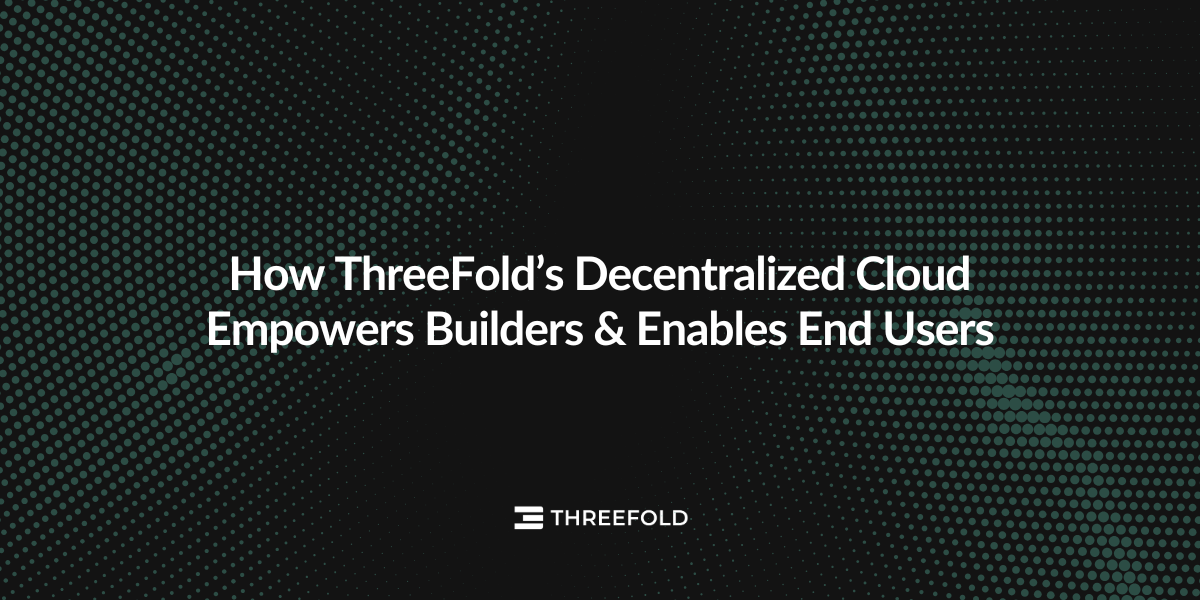How ThreeFold's Decentralized Cloud Empowers Builders – and End Users
ThreeFold isn’t just a vision for the future. It’s a functioning, decentralized infrastructure already in production.

A network of decentralized nodes around the world contribute compute, storage, and network capacity to the ThreeFold Grid, powering live workloads for developers and independent projects. This isn’t a vision for the future. It’s a functioning, decentralized infrastructure already in production.
While the ThreeFold team pushes forward on our own flagship commercial initiatives, builders are already commercializing the grid’s resources with consumer and enterprise products on top. Together, it’s forming an ecosystem where the infrastructure, builders, and users all reinforce one another.
🔗The Grid: The Foundation
At its core is the ThreeFold Grid, a global network of independently operated nodes. These nodes are run by “farmers,” aka individuals and organizations that contribute resources and are rewarded for making reliable resources available. Unlike hyperscalers, there is no central owner controlling pricing, access, or usage. Anyone can contribute hardware, anyone can consume capacity.
From a technical perspective, the grid offers the primitives developers need to run modern workloads: Linux VMs, private networking, IPv4/IPv6 routing, and the ability to deploy and manage infrastructure.
A key challenge in decentralized hosting has always been network access, especially scarce and expensive IPv4 addresses. The grid solves this with smart gateway models, such as the Web gateway that turn ThreeFold nodes with public IPv4 addresses into reverse proxies, making any workload accessible from the internet, even if it runs on a node without a public IP.
Farmers can offer gateway services using their own IPv4 addresses, so users can deploy anywhere on the grid without complex networking. This way, small operators can deploy apps without buying lots of expensive IPs.
Gateways can also bridge Mycelium with the traditional web. Mycelium is a decentralized, end-to-end encrypted network built on the ThreeFold base layer. Developers building directly on Mycelium can often skip IPv4 gateways entirely.
🔗The Builders: Turning Infrastructure into Products
Above the raw grid sits a growing layer of builders and companies who package its primitives into usable, commercial-grade products.
As concrete examples, we have YourData Network, a seller of hardware and software, and Shiloh Code, experts in privacy and managed services, that both leverage the grid in their own ways. We also have interesting experiments like this Ukrainian underground radio which can safely run using the Mycelium network without worrying about centralized censorship.
Independent developers are also using the grid to offer hosting and app gateways. A recent project showed that a single person could set up a reliable front door for many apps in just a few evenings – something that would normally require a lot more time and expensive infrastructure. This gateway experiment helps work around the current limits of decentralized hosting, such as IPv4 scarcity and the fact that many nodes run in residential settings without direct inbound access.
Each of these efforts turns the raw ThreeFold Grid into accessible, commercial-grade services, without the specific need of a central rollout.
This builder layer is critical and serves a clear purpose: by abstracting away the complexity of the grid, it makes it possible for end-users to access apps and services running on the grid through easy to use builders’ products.
🔗The Users: Plugging Into Decentralization
At the top of the stack are the end users, people and small teams who want to use products without running servers themselves. Thanks to the builder layer, there are already products and services offered on the internet that run on the grid, making it possible to benefit from a decentralized backbone without managing the infrastructure.
They do not need to know how the network works. They simply use products like a hosted drive, a secure gateway or a custom web service that runs on a decentralized backbone. For them it feels as easy as a normal cloud, but without lock-in, tracking or sudden price changes.
🔗Why This Matters Now
This is no longer just a vision. It’s a functioning ecosystem where people are building and deploying. The technology is ready for production. Compute, storage and networking primitives are live, open source and easy to automate with modern tools.
If you’re a developer or small company wanting to launch a product in a secure, decentralized environment, this is it. Here is what you should do:
- Explore the ThreeFold Grid
- Read through our manual
- Join the forum
The future of the internet isn’t coming – it’s already running. ThreeFold is ready for adoption.

